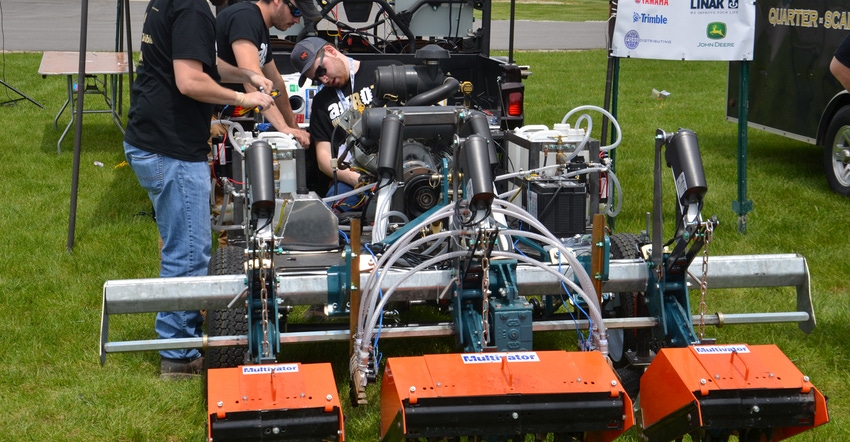June 13, 2019

Strange-looking contraptions filled the grass lots around the Beck Agricultural Center at Purdue University’s Agronomy Center for Research and Education. Developed by teams of college students from around the country, the contraptions competed for prize money; they also demonstrated where technology could go in the future.
The teams were competing in the AgBot Challenge, started by Steve Gerrish and his daughter, Rachel, on their farm near Rockville, Ind. Purdue joined in this year and hosted the event. From what we saw, the contest is blossoming into a celebration of the possibility of technology.
There were two competitions: one for teams that devised a machine that could weed and feed on its own, and one for teams that developed a machine that could pull and analyze samples autonomously on the go. It wasn’t only soil sampling — they could also sample for other things, such as nematodes.
Closer look
The team representing the Purdue Department of Agricultural and Biological Engineering brought a machine that might be a sign of things to come. Their goal was to turn loose an autonomous utility vehicle and let it identify weeds, then decide to either spray weeds if they were in the row, or use narrow cultivating units to mechanically remove weeds between rows.
“Last year’s team had a similar concept, but they couldn’t get everything to talk to each other,” says Roger Tormoehlen, an ABE faculty member and team adviser. “There was a hitch in getting the information detected from cameras out front to the rear of the machine where the action took place.”
For 2019, the ABE team added a student with a strong background in electrical engineering. Collaboration among various disciplines will be needed to make these concepts reality in the future, Tormoehlen says.
“This year different parts of the machine talked to each other, and it took out some weeds,” he reports. The entry won first place in the Weed and Feed competition.
Never say never
Dave Nanda, director of genetics for Seed Genetics-Direct and consultant for the Corn Watch ’19 project, continues to make the point that late-emerging corn plants that won’t contribute to yield are worse than weeds. You can kill weeds with herbicides, but they won’t kill corn.
Don’t be so sure that will always be the case, Dave! Eric Hawley, a research graduate with the University of Manitoba, accompanied that school’s entry in the AgBot Challenge. While this isn’t possible yet, Hawley thinks a machine may be able to distinguish between strong and weak corn plants in the future.
If it could identify weak plants, it could take them out, he says. That might make it possible to remove late-emerging plants within the row so remaining plants wouldn’t have unnecessary competition for sunlight and nutrients.
“We think the idea has merit, and we see how it might be possible to do it,” he says.
Yes, it’s all about artificial intelligence and training machines to recognize one type of plant from another. Whether this set of students will figure out all the answers is hard to say.
What’s a given is that there will be more students and researchers behind them. Don’t be surprised if one day soon, a practical, affordable machine that can operate on its own and take out one specific weed, or even puny corn plants, appears on the horizon.
Comments? Email [email protected].
You May Also Like




